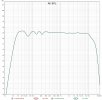Hi There! I'm planning to actively triamp my speakers. My current setup is as follows: pc (with Rew, RePhase and Eq Apo > Topping D50s > ZeroZone Irs 2092 monoblocks https://it.aliexpress.com/item/32904122947.html > Wharfedale Linton Heritage https://www.wharfedale.co.uk/linton-heritage/ (sensitivity 88-90 db, crossover 600 and 2400 Hz). Since the Lintons are three-way speakers, I'm wondering if I could remove the passive crossover and use the ZeroZones for the woofers and separate amps for midrange and tweeters. The crossover may be implemented in the digital domain with RePhase and Eq. Apo. A six-channel interface would substitute the Dac.
I have several doubts. First: is the entire endeavor worth it? After all, with Room correction I already have a quite flat response - see the attached image from Rew. Can removing the passive crossover increase the dynamic range and reduce the distortion? What about "semi-active" bi-amping: that is, disconnecting only the woofers from the passive crossover and using only two amps: one for woofers directly connected to drivers and one for mid-highs, connected to passive crossover. In this case, I could use a high-pass filter at, say 200 Hz.
Second question: which interface? Something from Motu or Focusrite?
Third: which amps for midrange and tweeters? I assume that I will be able to regulate the different sensitivities modifying the gain of the different channels. For midrange I've thought to amps like Topping PA5, Sabaj A8, SMSL DA 9, Aiyima A 07 or 08.
For tweeters: Topping PA3s, Sabaj A 10, SMSL A100, Aiyma A04.
Thank you in advance and sorry for my english.
Leonardo
I have several doubts. First: is the entire endeavor worth it? After all, with Room correction I already have a quite flat response - see the attached image from Rew. Can removing the passive crossover increase the dynamic range and reduce the distortion? What about "semi-active" bi-amping: that is, disconnecting only the woofers from the passive crossover and using only two amps: one for woofers directly connected to drivers and one for mid-highs, connected to passive crossover. In this case, I could use a high-pass filter at, say 200 Hz.
Second question: which interface? Something from Motu or Focusrite?
Third: which amps for midrange and tweeters? I assume that I will be able to regulate the different sensitivities modifying the gain of the different channels. For midrange I've thought to amps like Topping PA5, Sabaj A8, SMSL DA 9, Aiyima A 07 or 08.
For tweeters: Topping PA3s, Sabaj A 10, SMSL A100, Aiyma A04.
Thank you in advance and sorry for my english.
Leonardo

